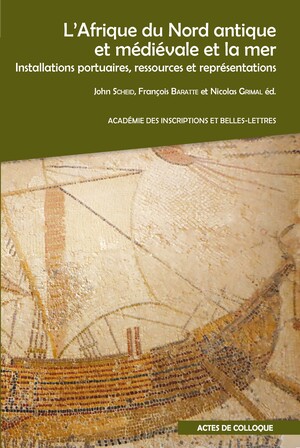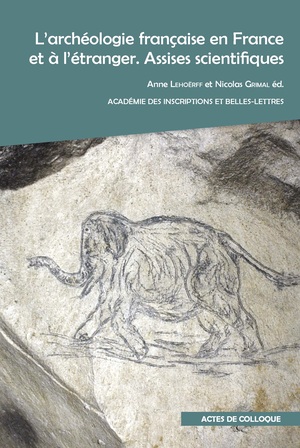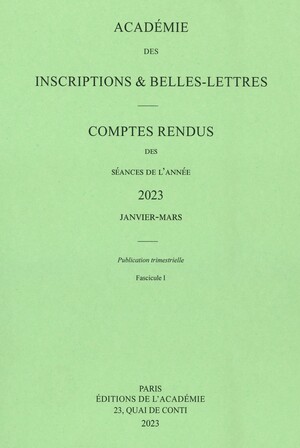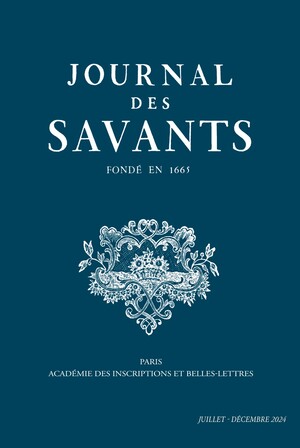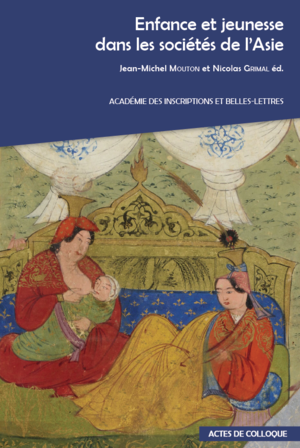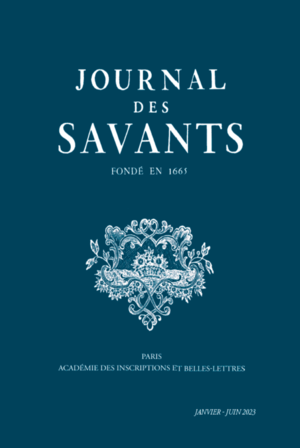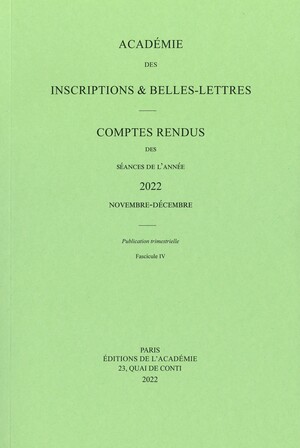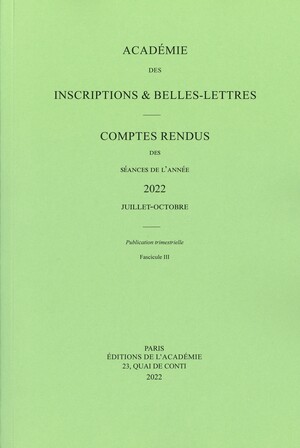Publications Archivum Latinitatis Medii Aevi 76, 2018
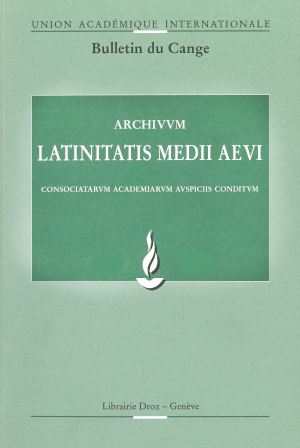
Archivum Latinitatis Medii Aevi, n° 76
Date : 2018
391 pages.
Pour se procurer ces périodiques :
Librairie Droz, 11 rue Massot Case Postale 389
1211 Genève 12 – Suisse
Tél : +41 22 346 66 66 ; Fax : +41 22 347 23 91
Site : www.droz.org
Courriel : droz@droz.org
Présentation
MORRESI I., I Principia geometricae disciplinae : formazione e fortuna di una traduzione latina da Euclide, p. 23-59
RIASSUNTO. – I Principia geometricae disciplinae sono un breve trattato interpolato all’interno delle Institutiones saeculares cassiodoree (redazione Δ), costituito da estratti da una traduzione latina – tradizionalmente attribuita a Boezio – degli Elementa euclidei. Scopo del contributo è quello di indagare gli esatti rapporti tra i Principia e gli altri discendenti altomedievali della medesima traduzione (la famiglia Palatina degli Agrimensores, la cosiddetta Prima Geometria pseudo-boeziana e la Seconda Geometria pseudo-boeziana), valutando in modo approfondito i pochi elementi a nostra disposizione per definire la natura e la collocazione del perduto archetipo M. Particolare attenzione è quindi dedicata alla relazione tra i Principia e due testimoni indiretti di notevole valore, le Etymologiae di Isidoro e il Liber glossarum, che incorporano brevi citazioni dallo stesso testo dell’Euclide latino ‘boeziano’.
ABSTRACT. – The treatise known as Principia geometricae disciplinae is a short text transmitted within the Δ recension of Cassiodorus’ Institutiones saeculares. It is composed of excerpts from a Latin translation – traditionally ascribed to Boethius – of Euclid’s Elementa. This essay focuses on the relationship between the Principia and other Medieval descendants from the same Euclidean translation, that is, the ‘Palatine’ collection of the Corpus Agrimensorum and the so-called ‘Geometria I’ and ‘Geometria II’ ascribed to Boethius. It aims to investigate the exact connection between these texts, focusing on what we can actually infer about the nature and localization of their lost archetype M. Closer attention is then payed to the Euclidean quotations inside Isidore’s Etymologies and the Liber Glossarum, two relevant indirect testimonies of M, whose nature and stemmatic position is further investigated.
GRONDEUX A., CINATO F., Nouvelles hypothèses sur l’origine du Liber glossarum, p. 61-100
RÉSUMÉ. – Le Liber glossarum est généralement présenté comme un glossaire inspiré des Étymologies d’Isidore de Séville. On montre ici qu’il est encore plus étroitement lié à l’encyclopédie sévillane, au sens où il préserve plusieurs états des dossiers isidoriens : les dépouillements préparatoires, des rédactions intermédiaires, les aboutissements ultimes, toujours fidèles à la famille espagnole des Étymologies. Plus que d’un glossaire ou d’une encyclopédie alphabétique, il s’agit d’un produit hybride qui fusionne des florilèges et des glossaires.
ABSTRACT. —The Liber glossarum is generally presented as a glossary borrowing from the Etymologies of Isidore of Seville. It is shown here that it is even more closely linked to the Sevillian encyclopaedia, having preserved several stages of Isidore’s work: preparatory material, intermediate drafts, ultimate redactions, being always faithful to the Spanish family of the Etymologies. More than a glossary or an alphabetical encyclopedia, the Liber glossarum is a hybrid work merging florileges and glossaries.
PLOCHARZ P., Quelques réflexions sociolinguistiques sur les canons des conciles mérovingiens (VIe-VIIe siècles), p. 101-114
RÉSUMÉ. — Dans cet article, nous analysons quelques canons des conciles mérovingiens des VIe et VIIe siècles. Une analyse sociolinguistique confirme que la Gaule du haut Moyen Âge est un pays entièrement latinophone. La lecture de ces textes ecclésiastiques dans le contexte de l’histoire de la littérature française pourrait suggérer que les racines des jongleurs médiévaux remonteraient jusqu’au VIe siècle, une époque beaucoup plus ancienne que nous ne le pensions.
ABSTRACT. – This article analyses canons of the Merovingian synods of the sixth and seventh century. Our sociolinguistic analysis confirms that early medieval Gaul was a full Latin-speaking country. Taking into account the history of medieval French literature, the analysis of these canons might suggest that the sources of medieval goliards date back much earlier than we thought, as early as the sixth century.
PARTOENS G., DE MAEYER N., A more original version of the Homilia sacra in ms. Köln, Dombibliothek, 117. Introduction, critical edition, and discussion of its relation to the Scarapsus, p. 115-154
ABSTRACT. — The Homilia sacra is an anonymous Late Antique or Early Medieval sermon previously known via only one manuscript (Copenhagen, Kongelige Bibliotek, Gl. Kgl. Saml. 1943. 4°, 9th c.), which draws on a variety of sources (including Caesarius of Arles’ sermons and Martin of Braga’s De correctione rusticorum) and shares several passages with the so-called Scarapsus, a catechetical homily often – though mistakenly – attributed to St. Pirminius († 753 [?]). This article presents the discovery of a second, much longer version of the Homilia sacra, preserved in ms. Köln, Dombibliothek, 117 (9th c.), and discusses its contents, structure, and sources as well as the relation (1) between the two versions of the Homilia sacra and (2) between the Homilia sacra and the Scarapsus. A critical edition of the second version of the Homilia sacra as well as a new transcription of the Copenhagen version are provided at the end of the article.
RÉSUMÉ. — L’Homilia sacra est un sermon anonyme issu de l’Antiquité tardive ou du haut Moyen Âge, connu jadis par le biais d’un manuscrit unique (Copenhague, Kongelige Bibliotek, Gl. Kgl. Saml. 1943. 4°, IXe s.), qui s’appuie sur une variété de sources (dont les sermons de Césaire d’Arles et le De correctione rusticorum de Martin de Braga) et partage plusieurs passages avec le Scarapsus, une homélie catéchétique attribuée – erronément – à saint Pirmin († 753 [?]). Le présent article porte sur la découverte d’une seconde version plus longue de l’Homilia sacra, conservée dans le ms. Cologne, Dombibliothek 117 (IXe s.). Il aborde, d’une part, le contenu, la structure et les sources de la seconde version et, d’autre part, les relations existantes entre les deux versions de l’Homilia sacra ainsi qu’entre l’Homilia sacra et le Scarapsus. Une édition critique de la seconde version de l’Homilia sacra et une nouvelle transcription de la version de Copenhague sont disponibles en fin d’article.
O’SULLIVAN S., Scholia non serviana, Lactantius Placidus, the Vatican Mythographers and mythological lore: A case study of Montpellier, Bibliothèque interuniversitaire, Section médecine, H 253, p. 155-188
ABSTRACT. —Scholia non serviana appear often in early medieval Vergil manuscripts. Analogues are found in medieval glossographic, encyclopaedic and mythographic collections. Montpellier, Bibliothèque interuniversitaire, Section médecine, H 253 is a case in point. Some of the glosses in the manuscript transmit material that closely resembles the commentary on Statius’s Thebaid ascribed to Lactantius Placidus and information found in the First and Second Vatican Mythographers. The shared content marks Lactantius as an important conduit of Graeco-Roman mythology. It also demonstrates that mythological lore in early medieval Vergil manuscripts circulated in other works.
RÉSUMÉ. —Les Scholia non serviana apparaissent souvent dans les manuscrits de Virgile du début du Moyen Âge. On trouve des analogies avec les collections médiévales glossographiques, encyclopédiques et mythographiques. Montpellier, Bibliothèque interuniversitaire, Section médecine, H 253 en est un exemple. Quelques unes des gloses du manuscrit transmettent du matériel qui ressemble beaucoup au commentaire sur la Thébaïde de Stace attribué à Lactantius Placidus et à l’information trouvée dans les premier et second Mythographes du Vatican. Le contenu partagé marque Lactantius comme un vecteur important de la mythologie gréco-romaine. Il démontre également que les traditions mythologiques des manuscrits de Virgile du début du Moyen Âge ont circulé dans d’autres œuvres.
PEZÉ W., Des rouleaux des morts inédits du haut Moyen Âge évoquant notamment l’archevêque Hugues de Reims, p. 189-208
RÉSUMÉ. —Cet article propose l’édition commentée de plusieurs rouleaux des morts et documents apparentés, datant des IXe-Xe siècles et venant s’ajouter à la courte liste des rouleaux du haut Moyen Âge. Deux rouleaux copiés dans le ms. BnF, latin 13351 sont originaires des abbayes de Saint-Denis et Prüm ; leur principal intérêt réside dans leur préambule, une partie du rouleau généralement éliminée lors de la copie des rouleaux dans les formulaires. Le rouleau de Saint-Denis est stylistiquement proche des rouleaux du Bassin parisien préservés dans le ms. BnF, latin 11379. Le rouleau de Prüm, en revanche, est plus original. D’une part, il apporte une nouvelle preuve des liens entretenus par Prüm en Francie occidentale à la fin de la période carolingienne. D’autre part, il s’agit d’un texte au style précieux et alambiqué, largement inspiré de l’œuvre d’Aldhelme de Malmesbury, ce qui démontre la compétition littéraire que se livrent les abbayes à travers les rouleaux. Par ailleurs, le ms. BnF, latin 1597A, a préservé, comme formulaire, une série de titres (ou réponses aux rouleaux) originaires de Reims, dans la première moitié du Xe siècle. Ces titres font référence au jeune archevêque Hugues, fils d’Herbert II de Vermandois, ainsi qu’à l’hôtelier Giso attesté dans d’autres sources, ce qui permet de les dater des années 920, confirmant le diagnostic paléographique de Bernhard Bischoff.
ABSTRACT. —This paper proposes the edition and commentary of several rolls of the dead from the 9-10th c., hitherto unpublished. They contribute to a better understanding of this literary genre in the Early Middle Ages. The two first rolls were copied in ms. BnF, latin 13351 and come from the abbeys of Saint-Denis and Prüm. Their preamble is their most interesting feature, since only a handful of early medieval rolls, most of them having been copied in formularies, have preserved their preamble. The Saint-Denis roll is stylistically similar to the few other known preambles, all of them copied in ms. BnF, latin 11379. The Prüm roll, on the contrary, is a very original piece. It gives new evidence of the connections between Prüm and West Francia through the End of the Carolingian period. Moreover, it is written in a mannered and convoluted latin, which draws its inspiration from the works of Aldhelm of Malmesbury. Rolls such as this one were obviously part of the cultural competition between monasteries. On another hand, ms. BnF, latin 1597A, has preserved several answers to mortuary rolls, that were copied in it as a formulary. All of these answers come from where they were copied : Rheims, mostly the abbey of Saint-Remy, and date back to the first half of the 10th century. These texts make reference to the young archbishop Hugo, son of Herbert II of Vermandois, and to the frater hospitalis Giso, attested by other sources. These references make it possible to date these pieces in the 920s, shortly after Herbert’s seizure of power in Rheims, thus confirming Bernhard Bischoff’s palaeographical datation.
D’ARGENIO E., Novità lessicali nel Codice Diplomatico Barese (secoli X-XIII)
RIASSUNTO. —Il Codice Diplomatico Barese è una delle raccolte documentarie più importanti dell’Italia meridionale e costituisce una preziosa fonte per arricchire e completare le informazioni disponibili nei dizionari del latino medievale. Il presente contributo segnala e analizza alcune novità lessicali dei primi due volumi del Codice Diplomatico Barese non registrate nei dizionari della latinità medievale. Si tratta di nuove grafie di termini già noti (alubnus, aurileria, berzarum, condaky, cossobrinus, cossoprinus, piziolum, pumettus), di neologismi semasiologici (ralla, trofa) e di neologismi semantici (addoator, azza, caditizzus, casanatizza, cocibelina, critazzina, crudia, cutizza, gayfus, naranginus, pellictionum, prekium, quartararus, scarparius, spurgator, termitosus).
ABSTRACT. – The Codice Diplomatico Barese is one of the most important documentary collections from Southern Italy and represents a valuable source to enrich the information available in the medieval Latin lexicographical works. The paper analyses some lexical innovations attested in the first two volumes of the Codice Diplomatico Barese and not included in the medieval Latin dictionaries. These lexical innovations are classified into three types : graphic variants of words already known (alubnus, aurileria, berzarum, condaky, cossobrinus, cossoprinus, piziolum, pumettus), semasiological neologisms (ralla, trofa/troppa) and semantic neologisms(addoator, azza, caditizzus, casanatizza, cocibelina, critazzina, crudia, cutizza, gayfus, naranginus, pellictionum, prekium, quartararus, scarparius, spurgator, termitosus).
LONATI E., Bartolomeo Anglico, « the English Pliny »?, p. 223-278
RIASSUNTO. —Il presente contributo si propone di condurre un’analisi esaustiva delle riprese che il De proprietatibus rerum del francescano Bartolomeo Anglico († dopo il 1245) trasse dalla Naturalis historia di Plinio il Vecchio, soprattutto in ambito zoologico e botanico. Rivelando un ampio numero di passi erroneamente attribuiti a Plinio, l’inchiesta spinge ad interrogarsi sulle ragioni dello scambio con auctoritates concorrenti, nonché a risalire alle vere fonti di determinate riprese, solo alla lontana dipendenti dalla Naturalis historia. Il confronto sistematico con il testo di quest’ultima offre inoltre l’occasione di identificare un piccolo gruppo di manoscritti pliniani, cui il modello di Bartolomeo presumibilmente apparteneva, e solleva numerose problematiche metodologiche soprattutto in merito a sezioni del De proprietatibus rerum ancora prive di un’edizione critica.
RÉSUMÉ. –Le présent article se propose de dresser une analyse globale des reprises que le De proprietatibus rerum du franciscain Barthélemy l’Anglais († après 1245) a faites à la Naturalis historia de Pline l’Ancien, surtout en matière de zoologie et de botanique. Révélant un bon nombre de passages qui sont attribués à tort à Pline, l’enquête encourage à s’interroger sur les raisons de l’échange avec des autorités concurrentes, ainsi qu’à remonter aux vraies sources de certaines reprises, qui n’ont qu’un lien très faible avec la Naturalis historia. De plus, une comparaison systématique avec le texte de cette dernière permet de détecter, au sein de la tradition directe, un petit groupe de manuscrits dont le modèle de Barthélemy faisait très probablement partie ; en même temps, elle pose de nombreuses questions de méthodologie surtout à propos de sections du De proprietatibus rerum encore dépourvues d’une édition critique.
ABSTRACT. – The aim of this article is to draw a broad analysis of the passages which the De proprietatibus rerum of the franciscan Bartholomew the Englishman († after 1245) took from Pliny the Elder’s Naturalis historia, namely about zoological and botanical topics. Showing that many quotations are wrongly attributed to Pliny, the enquiry urges to question about the reasons of the exchange with competing authorities and to find the real sources of some passages, weakly related to the Naturalis historia. Furthemore, the systematic comparison with its text allows to identify, within the direct tradition, a little group of manuscrits whose Bartholomew’s model was a part, and rises some methodological questions, primarily about sections of the De proprietatibus rerum which are not available in a critical edition.
MARTIN-IGLESIAS J. C., Los Miracula s. Brauli ep. Caesaraugustani saeculo XIII patrata (BHL 1448p): edición y estudio, con notas lingüísticas, p. 279-295
RESUMEN —El pergamino Zaragoza, Archivo Capitular, 1-1-1-8, transmite un pequeño relato sobre el hallazgo de los restos de san Braulio de Zaragoza en la basílica de Santa María la Mayor y veinticuatro milagros obrados por intercesión del santo entre 1249 y 1271: los Miracula s. Brauli ep. Caesaraugustani (BHL 1448p). Este artículo ofrece una nueva edición crítica de esta composición que viene a sustituir a la antigua edición de Fita de 1904, establece una doble autoría para las veinticuatro noticias de milagros, señala el uso de los Miracula s. Hilari ep. Pictauensis (BHL 3893) entre sus fuentes y analiza el latín en el que está redactada.
ABSTRACT. – The parchment Zaragoza, Archivo Capitular, 1-1-1-8, transmits a short story about the discovery of the remains of St. Braulio of Zaragoza in the Basilica of St. Mary Major and twenty-four miracles worked through the intercession of the saint between 1249 and 1271 : the Miracula s. Brauli ep. Caesaraugustani (BHL 1448p). This article offers a new critical edition of this composition that comes to replace the old edition of Fita of 1904, establishes a double authorship for the twenty-four news of miracles, points out the use of the Miracula s. Hilari ep. Pictauensis (BHL 3893) among its sources and analyzes the Latin in which it is written.
MENSA I VALLS J., Los neologismos bubulcaritas (y derivados) y bovizare en la obra espiritual latina de Arnau de Vilanova, p. 297-311
RESUMEN —Estudio de los neologismos bubulcaritas (y derivados) y bovizare en la obra espiritual de Arnau de Vilanova. Bubulcus, bubulcaritas, bubulcaris, bubulcariter aparecen treinta y ocho veces y bovizare dos, en obras escritas entre el año 1302 y 1305 (especialmente en el inédito Antidotum contra venenum effusum per fratrem Martinum de Atheca). Estos términos son utilizados en sentido figurado y sirven al médico y teólogo catalán para describir, calificar y, principalmente, reprobar la manera de razonar y de proceder en cuestiones teológicas de sus sus adversarios, los teólogos dominicos.
ABSTRACT. – Study of the neologisms bubulcaritas (and derived forms) and bovizare in the spiritual work of Arnau de Vilanova. Bubulcus, bubulcaritas, bubulcaris, bubulcariter appear 38 times, and bovizare twice, in works written between 1302 and 1305 (particularly in the unpublished Antidotum contra venenum effusum per fratrem Martinum de Atheca). These terms are applied figuratively and are used by the Catalan physician and theologian to describe, qualify and – above all – to reprove the ways in which his adversaries, the Dominican theologians, reasoned and proceeded in theological questions.
RÉSUMÉ. – Étude des néologismes bubulcaritas (et dérivés) et bovizare dans l’œuvre spirituelle d’Arnau de Vilanova. Bubulcus, bubulcaritas, bubulcaris, bubulcariter appa-raissent trente-huit fois et bovizare deux fois, dans des œuvres écrites entre les années 1302 et 1305 (plus particulièrement dans l’inédit Antidotum contra venenum effusum per fratrem Martinum de Atheca). Ces termes sont utilisés au sens figuré et servent au médecin et au théologien catalan pour décrire, qualifier et principalement réprouver la manière de raisonner et de procéder en matière de théologie de ses adversaires, les théologiens dominicains.
- SMIRAGLIA P., POLARA I., DE PRISCO A., Latinitatis italicae medii aevi lexicon. Addenda-Series altera. Fasc. 16 onerose – palor
- MORRESI I., I Principia geometricae disciplinae : formazione e fortuna di una traduzione latina da Euclide
- GRONDEUX A., CINATO F., Nouvelles hypothèses sur l’origine du Liber glossarum
- PLOCHARZ P., Quelques réflexions sociolinguistiques sur les canons des conciles mérovingiens (VIe-VIIe siècles)
- PARTOENS G., DE MAEYER N., A more original version of the Homilia sacra in ms. Köln, Dombibliothek, 117. Introduction, critical edition, and discussion of its relation to the Scarapsus
- O’SULLIVAN S., Scholia non serviana, Lactantius Placidus, the Vatican Mythographers and mythological lore : A case study of Montpellier, Bibliothèque interuniversitaire, Section médecine, H 253
- PEZÉ W., Des rouleaux des morts inédits du haut Moyen Âge évoquant notamment l’archevêque Hugues de Reims
- D’ARGENIO E., Novità lessicali nel Codice Diplomatico Barese (secoli X-XIII)
- LONATI E., Bartolomeo Anglico, « the English Pliny » ?
- MARTIN-IGLESIAS J. C., Los Miracula s. Brauli ep. Caesaraugustani saeculo XIII patrata (BHL 1448p) : edición y estudio, con notas lingüísticas
- MENSA I VALLS J., Los neologismos bubulcaritas (y derivados) y bovizare en la obra espiritual latina de Arnau de Vilanova

